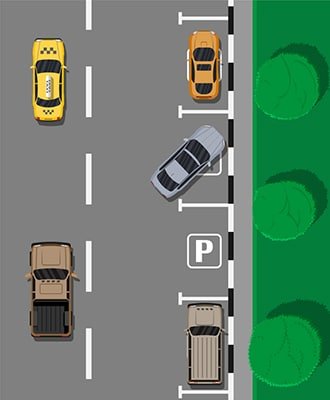Quiz: Parallel parking
Before you take the Ontario G1 written knowledge test, you can take our G1 practice test. These tests include everything you will need to know for the real test.
ADVERTISEMENT
Correct!
Wrong!
Correct!
Wrong!
Correct!
Wrong!
Correct!
Wrong!
Correct!
Wrong!
Share the quiz to show your results !
Subscribe to see your results
I got %%score%% of %%total%% right
More Learning Options:
Loading…
ADVERTISEMENT
Parallel Parking Tips - How to Parallel Park
Ask any driver you know what their least favorite maneuver is, and they’ll probably say parallel parking.
Parallel parking is quite a complicated driving move, but there are ways and tips on how to make it easier. Here’s how to parallel park for new drivers.
What is Parallel Parking?
Parallel parking is a parking method where you align your vehicle with other ones that are on the side of a road.
Aside from gauging the distance, drivers will need to have complete control over their cars in order to successfully execute this maneuver. You’ll need absolute confidence and lots of practice to get it done right.
4 Tips to Parallel Park Like a Pro
Positioning is Key
There are tried and tested ways to parallel park and in virtually any position too. As long as there’s enough space you’ll be able to execute the parking method in a sufficient manner.
At first, you’ll want to position your vehicle so it’s parallel to the car in front of the space in about 2 to 3 feet. Then, slowly reverse along the side and turn the steering wheel to the right as you do so. As you ease in the empty space you slowly straighten the steering wheel and assume a parallel position.
 Always Check Your Mirrors
Always Check Your Mirrors
With parallel parking, you’ll be using most, if not all the mirrors you have in your vehicle.
The maneuver consists of a forward drive, reverse, and steering. In all these cases you will want to check your rearview mirror and your side mirrors to see if there’s a pedestrian or another vehicle that might be in the way.
For vehicles with dash cams or rear dash cams, you can just look straight ahead instead of back to check for obstacles and people. This makes parking easier and eliminates the need to check the rear view or look outside the side window.
Stay Safe
Your desire to parallel park might not be obvious to some motorists, but your car does have the tools to make the surrounding traffic aware.
Whenever you intend to parallel park, immediately turn on your blinkers to signal those behind you that you want to park in the space. You can follow it up with hand gestures or by honking your horn. If the message is clear and pedestrians and drivers are moving past you, then it’s time to move towards the parking spot.
Exit with Confidence
When you’re ready to get your car out of the parking spot, here’s what you should do.
Ensure that there are no pedestrians behind you or the car on your back. Then, move your vehicle slowly in reverse, and as much as possible without bumping into it. Stop, turn the steering wheel to the left and shift the gear to move forward.
Use your side mirror to check for oncoming traffic before exiting the parking lane. If everything is clear, slowly move out and carefully avoid the front car’s back bumper. Exit and head towards your next destination.

 Always Check Your Mirrors
Always Check Your Mirrors